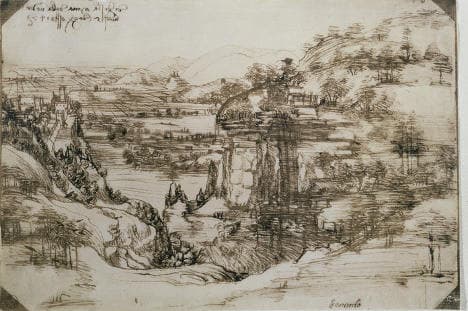Early Leonardo piece to be shown in artist’s home town

A landscape drawing by the Italian master artist, Leonardo da Vinci, will go on display in his native Tuscan town in commemoration of the 500th year since his death.
Florence’s Uffizi Gallery said it would loan the piece, called ‘Landscape Drawing for Santa Maria Della Nave’, to the Leonardiano Museum in Vinci, where the artist was born to a poor family in 1452.
The only drawback is that art lovers will have to wait until 2019 to take a peek at the rarely displayed landscape of the Arno river valley and Montelupo Castle. The piece, which is the first by Leonardo to be dated (August 5th 1473), will be on show for five weeks from August 5th 2019.

Photo: Nico Barbatelli - Museum of the Ancient People of Lucania/Wikicommons
Leonardo was among the Renaissance period's most famous artists, creating masterpieces including the Mona Lisa, which is on display at The Louvre in Paris, and The Last Supper. He was also an engineer and mathematician.
The artist died in Amboise, France, on May 2nd 1519. His remains were lost in the 16th century during the religious wars that followed his death.
Comments
See Also
Florence’s Uffizi Gallery said it would loan the piece, called ‘Landscape Drawing for Santa Maria Della Nave’, to the Leonardiano Museum in Vinci, where the artist was born to a poor family in 1452.
The only drawback is that art lovers will have to wait until 2019 to take a peek at the rarely displayed landscape of the Arno river valley and Montelupo Castle. The piece, which is the first by Leonardo to be dated (August 5th 1473), will be on show for five weeks from August 5th 2019.

Photo: Nico Barbatelli - Museum of the Ancient People of Lucania/Wikicommons
Leonardo was among the Renaissance period's most famous artists, creating masterpieces including the Mona Lisa, which is on display at The Louvre in Paris, and The Last Supper. He was also an engineer and mathematician.
The artist died in Amboise, France, on May 2nd 1519. His remains were lost in the 16th century during the religious wars that followed his death.
Join the conversation in our comments section below. Share your own views and experience and if you have a question or suggestion for our journalists then email us at [email protected].
Please keep comments civil, constructive and on topic – and make sure to read our terms of use before getting involved.
Please log in here to leave a comment.